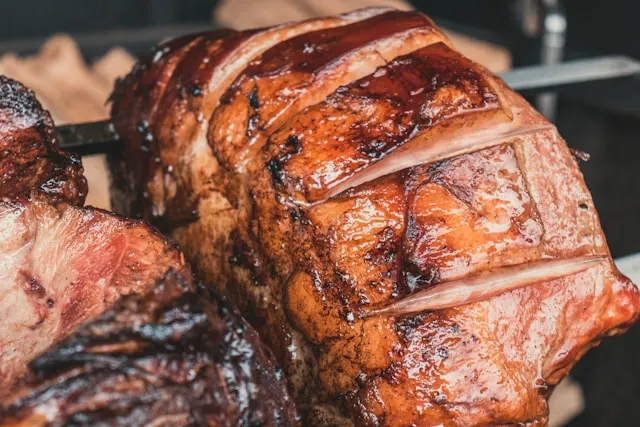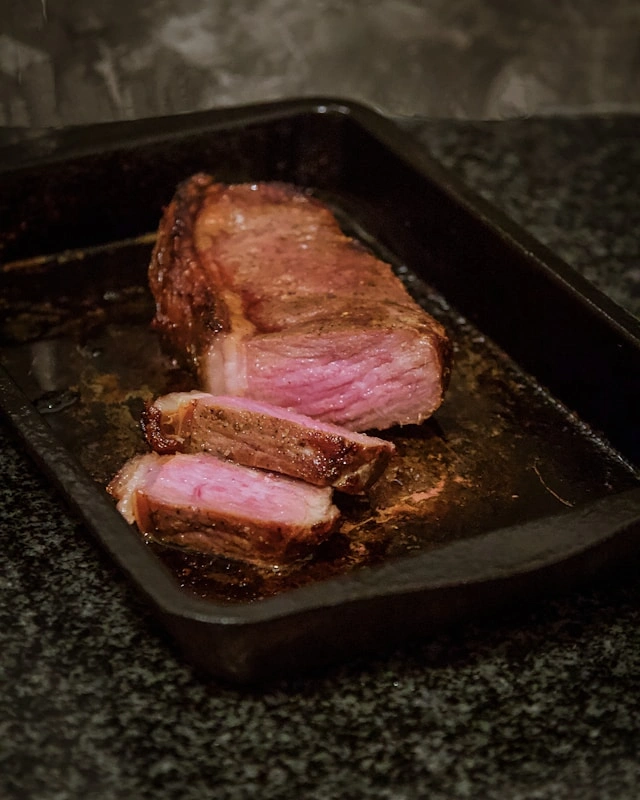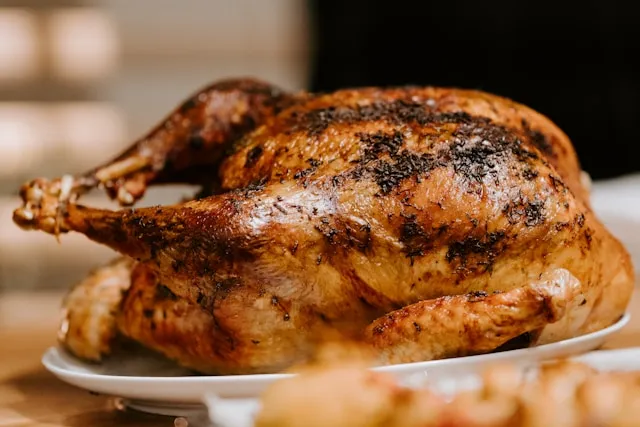Paleo diet

Paleo diet
The Paleo diet, also known as the “Caveman diet,” is an eating plan that focuses on foods that were likely consumed by early humans during the Paleolithic era. It eliminates grains, dairy products, legumes, added sugars, and processed foods, emphasizing whole, unprocessed foods such as meats, fish, fruits, vegetables, nuts, and seeds. Proponents of the Paleo diet claim that the consumption of grains, dairy, and processed foods is linked to chronic diseases, such as insulin resistance, digestive issues, and leaky gut syndrome. The diet has gained popularity for its potential benefits in weight loss, improved digestion, and increased energy.
The typical paleo diet emphasizes whole, unprocessed foods such as grass-fed meats, wild-caught fish, and fresh fruits and vegetables. It encourages excluding dairy products and grains due to their potential negative impact on human health. However, this diet may pose a risk of nutrient deficiencies, particularly in calcium and vitamin D, which are essential for maintaining strong bones.
This diet is not for everyone! Consult a specialist before starting it!
Principles of the Paleo diet
The Paleo diet, also known as the “Caveman diet,” is an eating plan that seeks to mimic the diet of our ancient ancestors. The core principle is to focus on whole, unprocessed foods that were likely consumed by early humans, such as meats, fish, fruits, vegetables, nuts, and seeds. Foods that are excluded or restricted include grains, dairy products, legumes, added sugars, processed foods, and foods with added salt or preservatives. By eliminating these modern food sources, the Paleo diet aims to promote a balanced diet that is rich in nutrients and minimizes inflammation.


What foods are in the Paleo diet?
The Paleo diet, also known as the “Caveman Diet,” focuses on whole, unprocessed foods that were likely consumed by early humans. The diet eliminates grains, dairy, processed foods, and sugars, instead emphasizing meats, fish, fruits, vegetables, nuts, and seeds. Some specific foods allowed on the Paleo diet include:
- Grass-fed meats (beef, pork, lamb, etc.)
- Wild-caught fish and seafood
- Pasture-raised eggs
- Fresh fruits and vegetables
- Nuts and seeds (including coconut, avocado, etc.)
- Healthy oils (olive, coconut, avocado, etc.)
This diet aims to mimic the diet of our ancestors, emphasizing whole, nutrient-dense foods for optimal health.
What foods are NOT in the Paleo diet?
The Paleo diet, also known as the “caveman diet,” focuses on consuming whole, unprocessed foods that were likely available during the Paleolithic era. The diet eliminates foods that became more common with the advent of farming and processing. Foods that are not part of the Paleo diet include grains, dairy products, legumes, added sugars, processed foods, and most salty and sugary snacks. These foods are considered non-Paleo because they were not a natural part of the hunter-gatherer diet. Stick to whole fruits, vegetables, lean meats, nuts, and seeds for a Paleo-friendly diet


What is the Main Idea of the Paleo Diet
The main idea of the Paleo diet, also known as the Paleolithic diet or caveman diet, is to emulate the dietary patterns of our ancient ancestors, specifically those who lived during the Paleolithic era. The central concept revolves around consuming foods that would have been available to hunter-gatherers in the pre-agricultural, pre-industrial era.
Key principles of the Paleo diet include:
Emphasis on Whole Foods: The diet focuses on whole, unprocessed foods such as lean meats, fish, seafood, fruits, vegetables, nuts, and seeds.
Exclusion of Processed Foods: The Paleo diet discourages or eliminates processed foods, refined sugars, trans fats, and artificial additives, which were not consumed by early humans.
Elimination of Grains and Legumes: The diet restricts or eliminates grains, including wheat, rice, and corn, as well as legumes such as beans, lentils, and peanuts, citing their introduction after the Paleolithic era.
Healthy Fats: The diet encourages the consumption of healthy fats from sources such as avocados, nuts, seeds, and oils, including olive oil and coconut oil.
Dairy: The Paleo diet typically excludes dairy products, as many advocates believe that early humans did not consume dairy beyond infancy due to a lack of domesticated animals.
Promotion of Nutrient-Dense Foods: The diet promotes nutrient-dense foods rich in vitamins, minerals, and antioxidants while aiming to minimize the intake of processed and potentially inflammatory ingredients.
Focus on Protein: The diet emphasizes the consumption of animal proteins and advocates for sustainably sourced, high-quality animal products.
The fundamental idea behind the Paleo diet is to align modern eating habits with the presumed dietary patterns of our early ancestors, with the goal of potentially improving overall health, supporting weight management, and reducing the intake of processed and potentially inflammatory foods. While the diet has gained popularity, it’s important to note that the specific dietary habits of ancient humans can be challenging to accurately replicate, and individual nutritional needs may vary based on factors such as genetic heritage and lifestyle. As with any significant dietary change, it’s advisable to approach the Paleo diet with a balanced and informed perspective, considering individual health needs and consulting with a healthcare professional or registered dietitian if necessary.
The Way to follow the Paleo diet properly
Following the Paleo diet properly involves adhering to specific guidelines and principles that focus on consuming whole, unprocessed foods while excluding certain food groups that were not available to early humans. Here’s a step-by-step approach to follow the Paleo diet:
Understand the Principles: Familiarize yourself with the core principles of the Paleo diet, including the emphasis on whole foods, the exclusion of processed ingredients, and the avoidance of grains, legumes, and dairy.
Stock Up on Whole Foods: Fill your kitchen with an array of whole foods, including lean meats, fish, seafood, eggs, vegetables, fruits, nuts, and seeds. Opt for organic and grass-fed options when possible.
Eliminate Processed Foods: Remove processed foods, refined sugars, hydrogenated oils, and artificial additives from your diet. This includes packaged snacks, sugary drinks, processed meats, and foods with lengthy ingredient lists.
Avoid Grains and Legumes: Restrict or eliminate grains such as wheat, rice, and corn, as well as legumes like beans, lentils, and peanuts.
Limit Dairy: The Paleo diet typically excludes dairy products, but some individuals may choose to include small amounts of certain dairy options such as grass-fed butter or ghee.
Prioritize Healthy Fats: Incorporate healthy fats from sources like avocados, nuts, seeds, and oils such as olive oil and coconut oil into your meals.
Vary Your Protein Sources: Consume a variety of animal proteins, including grass-fed beef, poultry, wild-caught fish, and eggs. Explore alternative protein sources such as nuts, seeds, and plant-based protein sources if desired.
Load Up on Vegetables and Fruits: Make vegetables and fruits the cornerstone of your meals, aiming for a diverse range of produce to maximize nutrient intake.
Read Labels Carefully: When purchasing packaged foods, carefully scrutinize ingredient lists to ensure they align with the Paleo diet’s restrictions on processed and non-compliant ingredients.
Explore Paleo-Friendly Recipes: Get creative in the kitchen and explore a wide array of Paleo-friendly recipes and cooking methods. Many resources, including cookbooks and online platforms, offer a wealth of inspiration for Paleo meals.
Listen to Your Body: Pay attention to how different foods make you feel and adjust your food choices based on your individual response. Some individuals find that reintroducing certain food groups, such as dairy or legumes, in moderation works well for them, while others may prefer a more stringent approach.
As with any significant dietary change, it’s beneficial to seek support from the Paleo community, engage with like-minded individuals, and consider consulting with a registered dietitian or healthcare professional for personalized guidance. Remember that the Paleo diet is a framework that can be adapted to fit individual needs and preferences while maintaining a focus on whole, nutrient-dense foods.


Is the Paleo Diet compatible with high physical activity and athletics?
The Paleo diet can be compatible with high physical activity and athletics, but it may require careful planning to ensure that individuals engaged in intense exercise have adequate energy and nutrient intake to support their performance and recovery needs. Here are some factors to consider when assessing the compatibility of the Paleo diet with high physical activity and athletics:
Carbohydrate Needs: Athletes engaging in high-intensity workouts or endurance activities often have increased carbohydrate requirements to fuel their performance and replenish glycogen stores. The Paleo diet’s restriction of grains and legumes, which are traditional carbohydrate sources, may require athletes to find alternative sources such as starchy vegetables, fruits, and root vegetables to meet their carbohydrate needs.
Protein Intake: The Paleo diet’s emphasis on lean meats, fish, and eggs can provide ample protein to support muscle repair and recovery, which is vital for athletes. Protein requirements may be higher for individuals engaged in intense training, and it’s essential to ensure they are met through a variety of protein sources.
Healthy Fats for Sustained Energy: The healthy fats encouraged on the Paleo diet, such as those from avocados, nuts, seeds, and oils, can provide a source of sustained energy for endurance activities and may support overall athletic performance.
Micronutrient Considerations: Athletes have increased micronutrient needs due to higher levels of physical activity. It’s important to ensure that the Paleo diet includes a variety of vegetables, fruits, and nuts to provide essential vitamins and minerals necessary for optimal athletic performance and recovery.
Hydration: While the Paleo diet itself does not dictate hydration practices, athletes must prioritize adequate hydration to support exercise performance and recovery.
Individual Adaptation: Some athletes may find that certain aspects of the Paleo diet need to be adapted to support their specific training regimen and performance goals. This could involve strategic carbohydrate intake around workouts, post-training protein and carbohydrate replenishment, and overall energy balance.
Consultation with a Professional: Athletes with specific performance and recovery goals, or those navigating high levels of physical activity, may benefit from consulting with a sports dietitian or nutrition professional who can help tailor the Paleo diet to their individual needs.
In summary, the Paleo diet can offer a framework for supporting the nutritional needs of athletes, especially when focusing on whole, nutrient-dense foods. However, individuals engaged in high physical activity and athletics should remain attentive to their specific performance and recovery requirements and be prepared to adapt the diet to ensure it meets their energy, macronutrient, and micronutrient needs. Prioritizing a diverse and adaptable approach to nutrition is crucial for athletes aiming to optimize their performance while following the Paleo diet.
Does the Paleo diet help you lose weight and become slim?
The Paleo diet has been associated with weight loss and improved body composition for some individuals. Several factors contribute to this association:
Emphasis on Whole Foods: The Paleo diet encourages the consumption of whole, unprocessed foods such as lean meats, fish, vegetables, fruits, nuts, and seeds. By focusing on these nutrient-dense options, individuals may naturally reduce their intake of processed and calorie-dense foods, potentially leading to a reduction in overall calorie consumption.
Elimination of Processed and Sugary Foods: By avoiding processed foods and refined sugars, individuals following the Paleo diet often reduce their intake of empty calories and added sugars, which can contribute to weight management and improved metabolic health.
Focus on Satiety: The Paleo diet’s emphasis on protein, healthy fats, and fiber-rich foods may promote feelings of fullness and satiety, potentially leading to reduced overall food intake and better appetite control.
Removal of Potentially Inflammatory Foods: By eliminating grains, legumes, and dairy, some individuals may experience reduced bloating, improved digestive comfort, and lowered intake of foods to which they may have sensitivities, which can positively impact overall well-being and potentially support weight management.
Potential Impact on Metabolism: Some proponents of the Paleo diet suggest that the emphasis on whole, nutrient-dense foods and the removal of processed ingredients may positively influence metabolic health, potentially supporting weight loss and body composition changes.
However, it’s important to note that individual responses to any diet, including the Paleo diet, can vary widely. Factors such as genetics, activity level, overall calorie intake, and individual metabolic differences all play a significant role in how one’s body responds to dietary changes.
Additionally, while some individuals may experience weight loss and improved body composition on the Paleo diet, others may not see the same results. Long-term adherence to any dietary approach, as well as a holistic focus on lifestyle factors including physical activity, stress management, and sleep, are crucial for achieving and maintaining a healthy weight and overall well-being.
As with any significant dietary change, it’s advisable to approach the Paleo diet with a balanced and informed perspective, considering individual health needs, and consulting with a healthcare professional or registered dietitian if necessary. Individualized guidance and support can help ensure that the diet is effectively leveraged to support weight management and overall health goals.


Is the Paleo Diet safe for health and anyone can follow it? Do I need to consult a nutritionist to start following this diet?
The Paleo diet is generally considered safe for most healthy individuals, but as with any significant dietary change, there are factors to consider before starting the program:
Underlying Health Conditions: Individuals with certain health conditions, such as diabetes, cardiovascular disease, or kidney issues, may need to adapt the Paleo diet to meet their specific needs. It’s recommended to consult with a healthcare provider or registered dietitian before starting the program if you have a medical condition or specific dietary restrictions.
Pregnancy and Breastfeeding: While the Paleo diet can be adapted for pregnancy and lactation, modifications are necessary to ensure adequate nutrient intake for both the individual and the baby. Consulting with a healthcare provider or a prenatal/postnatal nutrition expert is advisable in these cases.
Medical Advice: If you have a history of disordered eating, significant dietary restrictions, or other medical concerns, seeking guidance from a healthcare professional, such as a registered dietitian or nutritionist, is recommended before embarking on the Paleo diet.
Potential Nutrient Gaps: The restrictions on certain food groups in the Paleo diet, such as grains and dairy, may lead to potential nutrient gaps if not properly planned. Consulting with a nutrition professional can help ensure that your nutrient needs are being met while following the diet.
Individual Health Goals: If your primary goal for following the Paleo diet is weight loss, improving digestive health, identifying food sensitivities, or enhancing overall well-being, it can be beneficial to discuss these goals with a nutrition expert to tailor the program to your specific needs.
While it is not mandatory to consult a nutritionist before starting the Paleo diet, seeking professional guidance can provide personalized recommendations, address individual concerns, and help optimize the effectiveness and safety of the dietary program.
If you choose to follow the Paleo diet without consulting a nutritionist, it is important to thoroughly understand the program guidelines, plan your meals carefully to ensure nutritional balance, listen to your body’s signals, and make adjustments as needed. Being mindful of how your body responds to the dietary changes and seeking professional support if necessary can help you navigate the program successfully and in a way that promotes your health and well-being.
Is the Paleo diet good for the heart?
The Paleo diet, which emphasizes whole, unprocessed foods and excludes many processed ingredients, can have several potential benefits for heart health. Here are some ways in which the Paleo diet may support heart health:
Focus on Whole Foods: The Paleo diet encourages the consumption of whole, nutrient-dense foods such as lean meats, fish, vegetables, fruits, nuts, and seeds. These foods are rich in vitamins, minerals, antioxidants, and dietary fibers that can support heart health.
Reduction in Processed Foods: By eliminating processed foods, added sugars, refined grains, and artificial additives, the Paleo diet may lead to a lower intake of ingredients that can contribute to heart disease risk factors, such as high cholesterol levels, inflammation, and oxidative stress.
Healthy Fats: The diet includes sources of healthy fats like avocados, nuts, seeds, and oils such as olive oil and coconut oil. These fats can provide essential fatty acids, such as omega-3s, which have been associated with a reduced risk of heart disease.
Protein Quality: The emphasis on consuming lean sources of protein, such as grass-fed meats and wild-caught fish, provides essential amino acids without the potentially harmful effects of processed meats.
Potential Weight Management: The Paleo diet’s focus on whole, nutrient-dense foods and the elimination of processed ingredients may support weight management, and weight loss or maintenance can have a positive impact on heart health.
However, there are considerations to keep in mind regarding the Paleo diet and heart health:
Dietary Balance: It’s important to ensure a balanced intake of essential nutrients, especially since the diet restricts certain food groups such as grains and dairy. Careful meal planning to ensure sufficient intake of vitamins, minerals, and fibers is crucial for overall health, including heart health.
Individual Needs: Individuals with specific heart health concerns or medical conditions should consult with a healthcare provider or registered dietitian before embarking on the Paleo diet to ensure that the dietary recommendations align with their individual health needs.
Long-Term Adherence: While the Paleo diet can offer benefits for heart health, it’s essential to consider the sustainability of the diet in the long term and explore how it can be adapted to meet individual preferences and nutritional requirements.
In conclusion, the Paleo diet can be a heart-healthy dietary approach for many individuals due to its emphasis on whole, nutrient-dense foods and the exclusion of processed ingredients. When implemented thoughtfully and with attention to individual health needs, the Paleo diet can be a valuable tool in supporting heart health goals. As with any significant dietary change, consulting with a healthcare provider or registered dietitian can offer personalized guidance to ensure that the diet is supporting heart health effectively.


Paleo diet
The Paleo Diet, also known as the “Caveman Diet,” is a nutritional approach that focuses on foods that were likely consumed by early humans during the Paleolithic Era. This diet eliminates grains, dairy products, legumes, added sugars, and processed foods, instead emphasizing whole, unprocessed foods like lean meats, seafood, fruits, vegetables, nuts, and seeds. Proponents of the Paleo Diet claim that it can help with weight loss, improve overall health, and reduce the risk of chronic diseases. However, some critics argue that the diet is too restrictive and lacks sufficient scientific evidence to support its claims.

